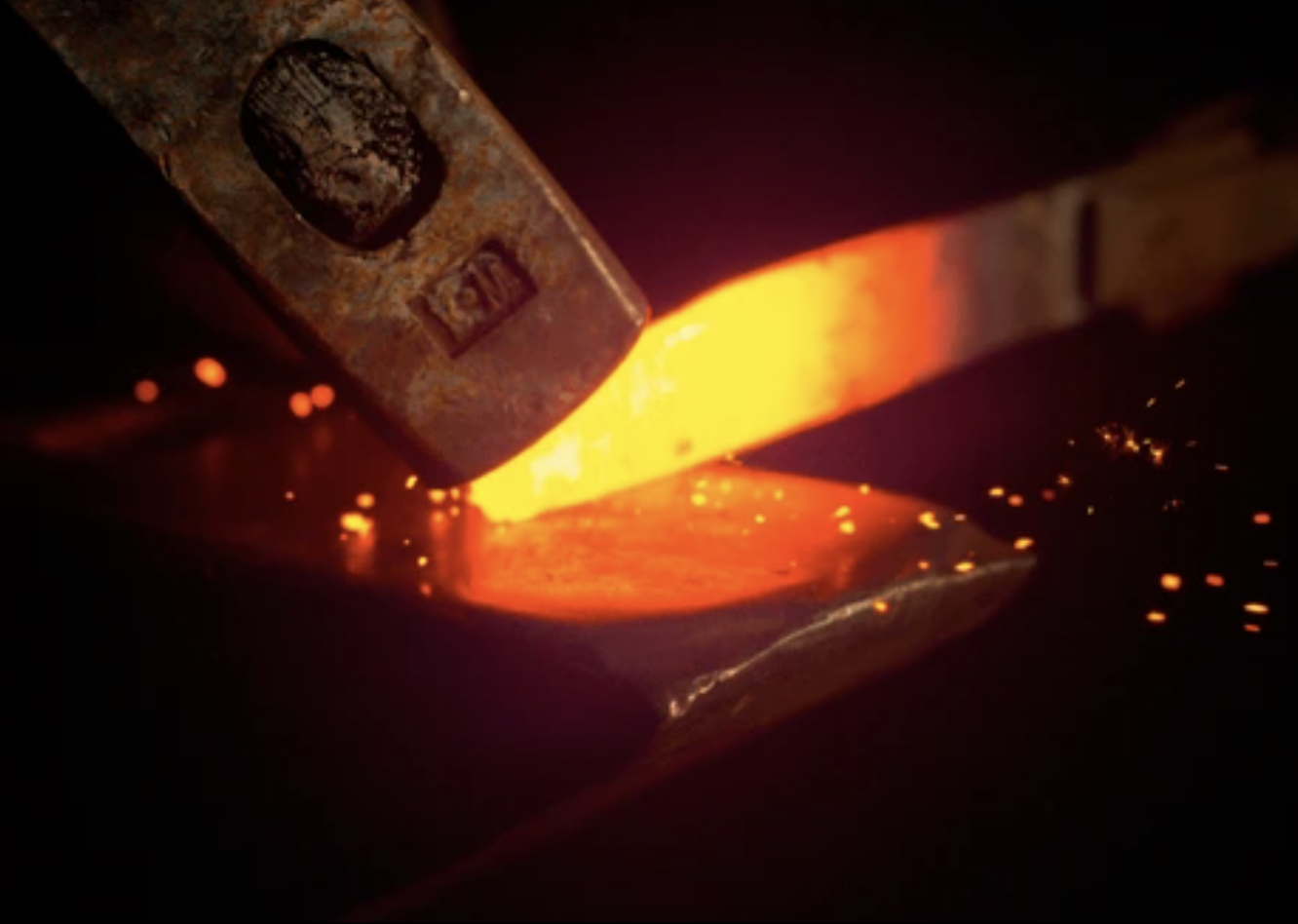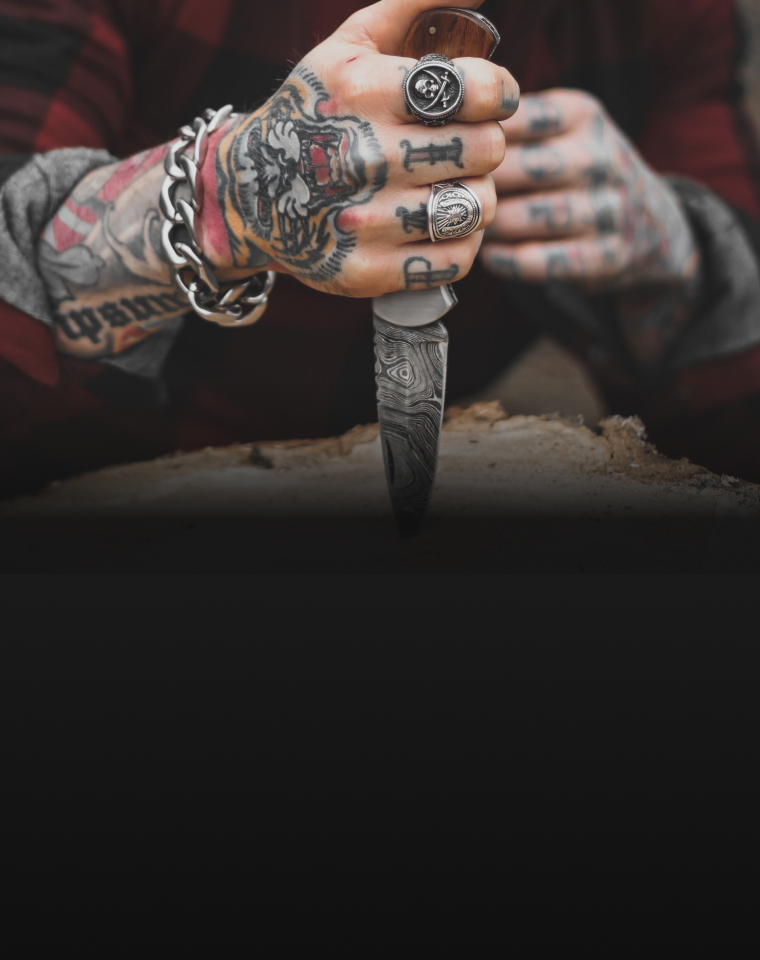The Art of Custom Damascus Steel Knife Making: Behind the Scenes at Grizzly Blades

When it comes to custom Damascus steel knives, the artisans at Grizzly Blades are true masters of their craft. The striking wavy patterns make the Damascus steel blade unique because no two patterns are alike and every time, it is a new design. But achieving that aesthetically mesmerizing pattern is truly a labor of passion and a testament to skill. Over the years, the blacksmiths at Grizzly Blades, have forged thousands of Damascus knives while ensuring that each knife is not only a high-performance tool but also a collectible work of art.
In this article, we are proud to share the intricate process behind these artisan knives to explain how our blacksmiths create your next favorite and functional Damascus knives.
A Brief Introduction to the History of Damascus Knives
The first mention of Damascus actually dates back to more than 2000 years ago. Originally, Damascus referred to swords made from a high-carbon steel alloy called wootz, created by mixing wrought iron and high-carbon materials such as charcoal, cast iron, or bits of wood and leaves inside a closed crucible vessel. This resulted in steel with just the right amount of carbon to make it strong yet flexible.
Back in the day, Wootz was a significant development and a big deal as the blades made from high-carbon crucible steel were resilient and could retain a sharp edge, unlike weapons made from other steels at the time which used to chip and lose sharpness easily. The presence of trace elements like vanadium and the formation of carbon compounds called carbides in Wootz steel also created a distinct banded pattern across the metal's surface, making it instantly recognizable.
Although Wootz was mainly produced in Central and South Asia, the Damascus blades forged from it were traded across the region, reaching into the Middle East and Europe during the Middle Ages. This is where these instantly distinguished blades got the name, “Damascus”. Although there's no said record, the name "Damascus" for these blades, may have been derived from the Arabic word for water (referring to the wave-like pattern on the blades) or named after a renowned swordmaker. Most sources associate Damascus, Syria, as the hub where many of these blades were forged and traded via the Silk Road to Europe.
Later in history, roughly a couple of hundred years, the Europeans started forging, trying to replicate the original Damascus knives and thus possibly created the modern day Damascus Steel Blades.
How are the Damascus Steel Blades Made Today?
The modern Damascus knife-making technique has moved beyond simply recreating the look of Wootz. With advancements in technology and steel alloys, Damascus now refers more to the appearance of a knife rather than the type of metal used. This has led to the association of Damascus knives with pattern-welded blades which involves stacking layers of separate alloys on top of each other, then heating and hammering them together in a process called forge welding. The folding process gives the knife its unique pattern and bladesmiths usually fold them in different directions to create different patterns.
Here’s the step-by-step fascinating process of how a Damascus Steel Knife is made in the Grizzly Blades forge.
Step 1: Collecting and layering the billets
The knife-making process begins with assembling the billets, which are stacks of different types of steel—typically high-carbon and high-nickel for that distinguished pattern. These layers are meticulously arranged and welded together to form a solid block. Depending on the desired characteristics of the blade, the number of layers can range from 60 to over 100.
Step 2: Heating in the furnace and folding
Next, the assembled billet, which looks like a block of different layers of steel is heated in a forge to temperatures exceeding 1000 degrees Celsius. Once the steel reaches the optimal temperature, it’s removed and hammered, folding the layers onto themselves. This folding process can be repeated many times, as every fold adds a new wave. This step is where the unique patterns are formed.
Step 3: Hammering the blade
This step is the most important one as this is where the steel is shaped into the desired blade form. The heated metal is hammered by a skilled blacksmith multiple times to ensure perfect thickness, edge, and geometry for optimal knife performance.
Step 4: Heat treatment and tempering
Once the blade is shaped, it is dipped in an anti-scale compound for about 10 minutes before it undergoes heat treatment to enhance its hardness and durability. Depending on the steel used, the blade is heated to a specific temperature and then cooled in a controlled manner to achieve an ideal combination of flexibility and hardness. This process usually involves three steps:
Austenitizing
Heating the steel to a specific temperature to transform the microstructure into austenite, a high-temperature iron phase.
Quenching
Rapidly cooling the steel to below the martensite start temperature, converting austenite to martensite, a hard but brittle phase.
Tempering
Reheating the steel to a lower temperature reduces the martensite's brittleness and achieves the desired balance of hardness and toughness.
Step 5: Etching and polishing to finish
The final stage of knife making is etching where the knife maker polishes the blade to remove any imperfections and then applies acid etching to highlight the beautiful Damascus pattern. The acid interacts with the different layers of steel, enhancing the contrast between high-carbon and high-nickel layers, resulting in a visually stunning finish that captivates chefs, hunters, and artisans alike.
Step 6: Crafting the handle and final assembly
This is the finishing step, where the blade gets attached to the handle. We at Grizzly blades, use wooden handles for a classic and natural look, with excellent grip and durability. And, not to forget, you can get the handle customized to add more character to your next blade so that it is truly unique to you.
And that's how your next Damascus steel knife is getting made in our Grizzly Blades forge as our skilled artisans put their passion and expertise into every knife, from the initial steel layer to the final polish, resulting in a unique, high-performance tool that is built to last. So wait no further, browse through our extensive collection of handcrafted Damascus Steel Knives and order your next blade from us. We provide shipping throughout Canada and the United States. Happy shopping!

